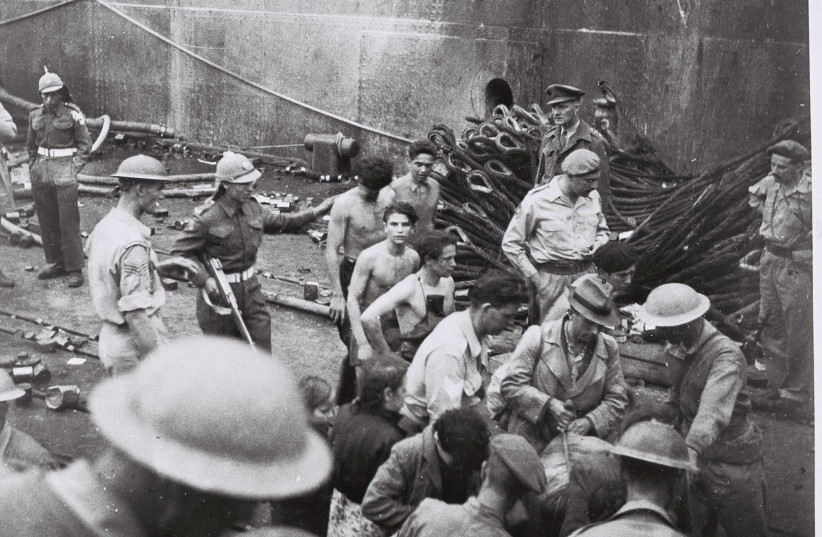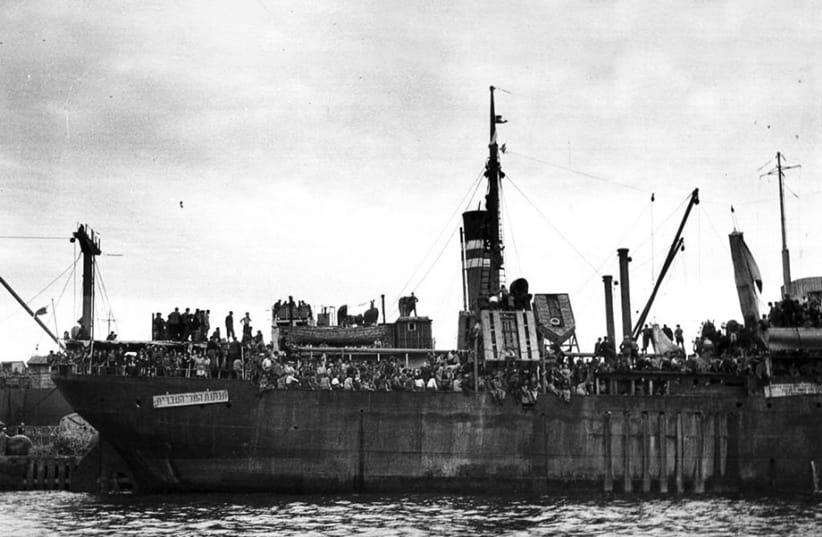There was great excitement last month at the Palmach House in Tel Aviv, where a conference commemorating 76 years since the arrival of the Knesset Israel illegal immigrant ship to the future State of Israel took place. Among the hundreds who attended the conference were 25 individuals who had actually been passengers on Knesset Israel.
They were very excited to greet old friends they hadn’t seen for decades and finally be able to introduce them to their children and grandchildren. Attendees of the conference, most of whom were descendants of Knesset Israel passengers, were looking forward to hearing about the most challenging experience their loved ones had ever experienced in their lives.
 Learn how to buy your home in Israel with confidence >>
Learn how to buy your home in Israel with confidence >>The Knesset Israel was a cargo ship built of iron in the US in 1892. Emissaries of the Mossad LeAliyah Bet (illegal immigration organization) had purchased the ship, and then sailed from the US to the port of Piraeus in Greece, loaded with cans and preserves. The plan was to sail from Greece to Israel. Mossad LeAliyah Bet members who joined the crew of the ship included Avraham Govsky, Binyamin Yerushalmi, and Yoash Chato Zidon, along with many others. When the British authorities discovered the illicit plan, they immediately issued an order to block the ship in Greece, but luckily the ship managed to slip away and sail for Port Bakar in Yugoslavia.
The commanders of the ship were Yosef Hamburger Harel and Palyam (Palmach’s Naval Platoon) member Reuven Hirsch Yatir. The original name of the ship was “The Jewish Resistance Movement,” but just a day before reaching Israel, its name was changed to the less provocative Knesset Israel in order to appease the British authorities.
On November 5, 1946, after two months of preparation, the ship set sail from Yugoslavia, carrying 3,400 immigrants. Around the same time, a smaller ship named Aba Berdichev with 600 people on board also set sail for Israel. During the journey, the smaller ship was swept against the rocks, crashed, and sank, so its passengers were transferred to the Knesset Israel. Most of the illegal immigrants were Holocaust survivors, including 1,500 youngsters who belonged to Jewish youth movements. On November 25, as the ship was approaching the port of Haifa, it was surrounded by three British Royal Navy destroyers.


When the British attempted to forcibly transfer the immigrants to three deportation ships that had been waiting for the Knesset Israel near Haifa’s port, a violent struggle broke out. During the confrontation, two Jewish immigrants were killed in the ensuing gunfire: Isaac Rosenboim, who was 16; and Chaim Mueller, 30, who was a member of Hashomer Hatzair. When the British threatened to harm the children, Yossi Harel – the ship’s commander – ordered all the immigrants to surrender. On November 27, 1946, all the male immigrants were transferred to detention camps in Cyprus, while the women and children were taken to the Atlit detention camp in Israel.
“WE EXPERIENCED many ups and downs during the voyage on the cargo ship. It had many sleeping compartments, and it was impossible to sit comfortably on board,” recalled 87-year-old immigrant Sarah Shefer. “My twin sister Leah and I reached the ship with help from our youth movement. We were so grateful to be on the ship, since we’d only recently survived the horrors of Dr. Mengele in Auschwitz, and we desperately wanted to reach the Land of Israel. Although the conditions on board the ship were challenging, everyone was really supportive of each other. Most of our family had perished in the Holocaust, and so the people on the ship became our new family. My name had been Vera, but when I arrived in Israel I was given a new name: Sarah.”
“Sarah boarded one ship, and I boarded another. For us, this gathering is a double celebration,” added Sarah’s husband, Eliezer, who is 100 years old. “I survived the Holocaust and labor camps. Our dream was to immigrate to the Land of Israel. We feel incredibly lucky that we were blessed with the opportunity to raise our family in the Jewish state. Just last year, we celebrated our 70th wedding anniversary.”
I saw a man in front of me, but before I was able to open my mouth to ask him a question, David Perlmutter, 76, whipped out his ID card and showed me that under “Country of Birth,” it said “Born at Sea.”
“My mother, Aiga, and my father, Simcha, who were both from Romania, boarded the ship in Zagreb,” David told me. “My mother and I were transferred to Atlit, while my father was sent to Cyprus – it took him six months until he was allowed to join us in Israel. Until today, people are amazed when I tell them I was born on an illegal immigrant ship making its way to Israel. I love telling people that story. I think this is why I have such a strong connection to the sea – and actually, my granddaughter is in the Israeli Navy and is currently stationed on board a ship.”
Shimon Lis, 89, from Moldova, traveled on the Knesset Israel at the age of 12. “My mother, my cousins, and I boarded the ship during a storm at sea,” he recounted. “The ship was so crowded that it was impossible to move around at all. Sometimes the ship would tip to one side, at which point they’d request that some people move to another spot on the ship in an effort to stabilize it.”
MICHAEL KAHANA, 85, was only eight years old when he boarded the ship. “I remember every detail from the voyage,” he explained. “The most challenging thing was the sleeping accommodations. The cabins were stacked one on top of another. I was a kid, so it was easy for me to climb up and down, but it was really hard for adults – especially tall ones. I boarded the ship with my aunt, who had escaped from Auschwitz. I remember her joking, saying that the living conditions on the ship were worse than at Auschwitz. For years and years, I couldn’t eat sardines, since that’s pretty much all we had to eat on the ship,” Kahana said with a smirk. “I was completely in awe of Yossi Harel, who commanded the entire ship, especially considering he was only in his 20s at the time of the voyage. He was our hero.”
Do you recall the skirmish that took place on board the Knesset Israel?
“Of course! Every day I would sit in the same spot at the front of the ship, so that I’d be able to escape if necessary. When the fighting began, they started throwing cans. When the British soldiers started bombarding us with tear gas, I quickly escaped to the lower deck so that I wouldn’t have to breathe in the awful gas.”
The conference also served as a book launch for a book written by Dr. Mordechai Saar Marmorstein, titled An Unusual Ship – The Full Story of the Immigration Ship Knesset Israel. Marmorstein was the first baby born on the ship, and he even underwent a brit milah (circumcision) while on board. He was given the additional name Saar (“storm”) by the ship’s wireless officer, Yoash Zidon, since there was a storm brewing all around the ship just as he was born.
“Twelve babies were born on board the immigration ship Knesset Israel,” Marmorstein said. “Two of them did not survive. There were 130 pregnant women on the ship. Since I was the first one born on this ship, I feel a strong sense of duty to tell the story of our voyage.
“It was the largest illegal immigrant ship that had ever set sail to Israel. In my book, I included a lot of important archival material that tells our story and highlights the ship’s significance. For example, I included details of all the radio transmissions between the immigration ship and the British destroyers, as well as documents related to the preparations for the confrontation we knew we would undergo with the British as we reached Israel’s shores. The purpose of my book – and of the conference as well – is to create a sense of family among all the descendants of the immigrants who had sailed on the Knesset Israel.
“I am delighted that so many people are here tonight at the Palmach House, over 76 years after the Knesset Israel voyage. This means there is a strong desire among the younger generation to hear their parents’ life stories and to create a Knesset Israel family. The previous conference for passengers who’d arrived on Knesset Israel took place in 1983, and many of the people who’d participated in that conference are no longer alive,” lamented Marmorstein.
“MY FATHER, Reuven Yatir, was Knesset Israel’s commander. My mother, Sari, was an immigrant on the ship,” explained Dita Bar-Yosef, 73. “The first moment my parents shared together was as they watched the immigrants arriving from Zagreb by train. Apparently, it was a very moving sight. My father was in charge of the entire ship – and he was only 21 years old! The only training he’d received was a course for Palyam boat commanders and a six-month naval engineering course at the Technion. He continued afterward to serve as a naval commander for many years.”
“After surviving the German concentration camps, my mother, Leah Butzi Shlomo, arrived in Budapest and joined the young Palmach members there,” recounted Ofrah Rozman. “They helped her reach the Knesset Israel. When the ship was intercepted by the British at the port in Haifa, my mother was transported to Cyprus by force. When the British were supposed to return the immigrants to Israel, there was a fear that they might regret their decision. The immigrants decided to blow up the ship to prevent it from being returned [to Europe]. One ship was, in fact, blown up.
“My mother was one of the illegal immigrants who boarded the ship with a bomb hidden in her bag. During the security check carried out by the British, my mother noticed that one of the security inspectors was a British woman she had been friendly with at the camp in Cyprus. So, my mother rushed to her, gave her a big hug, and made a big show of saying goodbye. Because they recognized each other, the female British soldier allowed my mother to board without undergoing an inspection. In the end, all the immigrants disembarked the ship, and the Jewish activists managed to blow it up.”
THE CONFERENCE opened with festive music and songs that immigrants used to sing on their way to Israel in the 1940s and 1950s. Afterward, guests listened to a few speeches, as well as a moving message from President Isaac Herzog, in which he said: “The story of Knesset Israel is an inspiring tale of courage. The Jewish immigrants fought like lions with sticks and cans of preserves. Their fearless spirit and brave deeds contributed greatly to the establishment of the State of Israel.”
One of the most memorable but heartbreaking experiences of the voyage was the burial at sea of a baby that was born on the ship. “Late at night, in an effort to minimize the parents’ pain, they wrapped up the baby that had died, placed him in an empty tin can, and recited the Kaddish, the prayer for the dead. When the next wave surged, Yossi Harel saluted and ordered the sailors to throw the can containing the body of the baby into the sea,” Marmorstein recounted at the conference. “Everyone who was on that ship will remember that moment for the rest of their lives.” ❖
Translated by Hannah Hochner.
 Sign up for our newsletter to learn more >>
Sign up for our newsletter to learn more >>